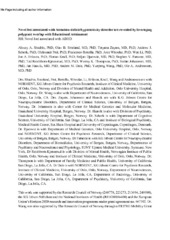| dc.contributor.author | Shadrin, Alexey A. | en_US |
| dc.contributor.author | Smeland, Olav Bjerkehagen | en_US |
| dc.contributor.author | Zayats, Tetyana | en_US |
| dc.contributor.author | Schork, Andrew J | en_US |
| dc.contributor.author | Frei, Oleksandr | en_US |
| dc.contributor.author | Bettella, Francesco | en_US |
| dc.contributor.author | Witoelar, Aree | en_US |
| dc.contributor.author | Li, Wen | en_US |
| dc.contributor.author | Eriksen, Jon Alm | en_US |
| dc.contributor.author | Krull, Florian | en_US |
| dc.contributor.author | Djurovic, Srdjan | en_US |
| dc.contributor.author | Faraone, Stephen V. | en_US |
| dc.contributor.author | Reichborn-Kjennerud, Ted | en_US |
| dc.contributor.author | Thompson, Wesley K | en_US |
| dc.contributor.author | Johansson, Stefan | en_US |
| dc.contributor.author | Haavik, Jan | en_US |
| dc.contributor.author | Dale, Anders | en_US |
| dc.contributor.author | Wang, Yunpeng | en_US |
| dc.contributor.author | Andreassen, Ole Andreas | en_US |
| dc.date.accessioned | 2019-06-18T11:29:45Z | |
| dc.date.available | 2019-06-18T11:29:45Z | |
| dc.date.issued | 2018-02 | |
| dc.Published | Shadrin AA, Smeland OB, Zayats T, Schork AJ, Frei O, Bettella F, Witoelar AW, Li W, Eriksen JA, Krull F, Djurovic S, Faraone SV, Reichborn-Kjennerud T, Thompson WK, Johansson S, Haavik J, Dale A, Wang Y, Andreassen OA. Novel loci associated with attention-deficit/hyperactivity disorder are revealed by leveraging polygenic overlap with educational attainment. Journal of the American Academy of Child and Adolescent Psychiatry. 2018;57(2):86-95 | eng |
| dc.identifier.issn | 0890-8567 | |
| dc.identifier.issn | 1527-5418 | |
| dc.identifier.uri | https://hdl.handle.net/1956/20183 | |
| dc.description.abstract | Objective Attention-deficit/hyperactivity disorder (ADHD) is a common and highly heritable psychiatric condition. By exploiting the reported relationship between ADHD and educational attainment (EA), we aimed to improve discovery of ADHD-associated genetic variants and to investigate genetic overlap between these phenotypes. Method A conditional/conjunctional false discovery rate (condFDR/conjFDR) method was applied to genome-wide association study (GWAS) data on ADHD (2,064 trios, 896 cases, and 2,455 controls) and EA (n=328,917) to identify ADHD-associated loci and loci overlapping between ADHD and EA. Identified single nucleotide polymorphisms (SNPs) were tested for association in an independent population-based study of ADHD symptoms (n=17,666). Genetic correlation between ADHD and EA was estimated using LD score regression and Pearson correlation. Results At levels of condFDR<0.01 and conjFDR<0.05, we identified 5 ADHD-associated loci, 3 of these being shared between ADHD and EA. None of these loci had been identified in the primary ADHD GWAS, demonstrating the increased power provided by the condFDR/conjFDR analysis. Leading SNPs for 4 of 5 identified regions are in introns of protein coding genes (KDM4A, MEF2C, PINK1, RUNX1T1),whereas the remaining one is an intergenic SNP on chromosome 2 at 2p24. Consistent direction of effects in the independent study of ADHD symptoms was shown for 4 of 5 identified loci. A polygenic overlap between ADHD and EA was supported by significant genetic correlation (rg=−0.403, p=7.90×10−8) and >10-fold mutual enrichment of SNPs associated with both traits. Conclusion We identified 5 novel loci associated with ADHD and provided evidence for a shared genetic basis between ADHD and EA. These findings could aid understanding of the genetic risk architecture of ADHD and its relation to EA. | en_US |
| dc.language.iso | eng | eng |
| dc.publisher | Elsevier | eng |
| dc.subject | attention-deficit/hyperactivity disorder | eng |
| dc.subject | educational attainment | eng |
| dc.subject | conditional/conjunctional false discovery rate | eng |
| dc.subject | genetic overlap | eng |
| dc.title | Novel loci associated with attention-deficit/hyperactivity disorder are revealed by leveraging polygenic overlap with educational attainment | en_US |
| dc.type | Peer reviewed | |
| dc.type | Journal article | |
| dc.date.updated | 2019-01-30T13:15:12Z | |
| dc.description.version | acceptedVersion | en_US |
| dc.rights.holder | Copyright 2017 American Academy of Child and Adolescent Psychiatry | |
| dc.identifier.doi | https://doi.org/10.1016/j.jaac.2017.11.013 | |
| dc.identifier.cristin | 1567090 | |
| dc.source.journal | Journal of the American Academy of Child and Adolescent Psychiatry | |
| dc.relation.project | Norges forskningsråd: 251134 | |
| dc.relation.project | Norges forskningsråd: 248778 | |
| dc.relation.project | Norges forskningsråd: 213694 | |
| dc.relation.project | EU: 667302 | |
| dc.relation.project | Norges forskningsråd: 248980 | |
| dc.relation.project | Norges forskningsråd: 223273 | |
